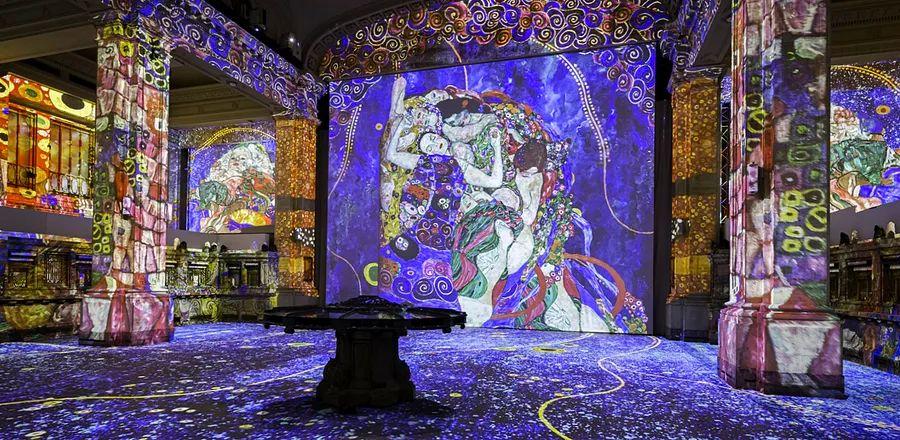New York City Unveils Its First Permanent Digital Art Center in a Revitalized Downtown Bank

Over the past 70 years, Manhattan’s Emigrant Industrial Savings Bank has transitioned from its original function to serve as a DMV, polling location, and temporary office space for city hall across the street. After three years of significant renovations, this Beaux Arts building has transformed into NYC’s inaugural permanent digital art center. Hall des Lumières opened its doors on September 14, featuring an opening exhibit dedicated to the works of Gustav Klimt, the Austrian artist pivotal to the Vienna secession movement in the early 20th century.
A collaboration between Culturespaces, a French museum organization, and media production company IMG, this new digital art venue employs numerous high-definition projectors to animate two-dimensional artworks. The inaugural exhibit, Gustav Klimt: Gold in Motion, showcases iconic masterpieces—including Portrait of Adele Bloch-Bauer I (1907) and Judith and the Head of Holofernes (1901)—set to a musical score that enhances their movement from floor to ceiling.

Photo by Mark Zhelezoglo for Hall des Lumières/Culturespaces
Revitalizing the Emigrant Industrial Savings Bank
After spending five to six years searching various locations in New York, Gianfranco Iannuzzi, the creative director of the show, finally selected the Emigrant Industrial Savings Bank. He expressed a preference for venues that require rejuvenation and have often been left unused for extended periods.
“I always seek a place with a narrative, a place that possesses a soul,” Iannuzzi remarked.
Opened in 1909, the Emigrant Industrial Savings Bank dates back to the same period as some of Klimt’s most celebrated works, including The Kiss (1907–1908). The restoration of this landmark building included the removal of smoke stains from when indoor smoking was permitted. Original features, such as ceiling laylights, the deposit slip station, and bank teller windows, have been preserved, while a platform was added at the back of the hall to provide visitors with an elevated view of the exhibit.
Beneath the main hall, the former bank vault is being transformed into a smaller gallery for contemporary artworks. Guests enter through the impressive vault door to find a mirrored space that reflects contemporary video art projections. This area debuted with Recoding Entropia, an apocalyptic film set in outer space by François Vautier.
How "Gustav Klimt: Gold in Motion" Stands Out Among Immersive Art Exhibitions
Currently, there are two additional digital Klimt exhibitions taking place in cities like Detroit and London. However, these are situated in temporary venues, often large warehouses with plain white walls.
“It’s crucial for me that it’s not just a square where you simply project an image—that’s too simplistic,” Iannuzzi explained. “I must tailor my work to fit the space. This particular space is incredibly impactful.”
While Iannuzzi has previously designed Klimt exhibitions projected at other Culturespaces locations, such as Atelier des Lumières in Paris and Fabrique des Lumières in Amsterdam, he customizes each show to the unique characteristics of the new venue, allowing the architecture to influence his artwork.
“The experience differs in Paris compared to New York or Seoul,” he noted. “Each location offers a unique perspective.”
The soundtrack for this exhibition is distinct and features music from composers like Ludwig van Beethoven, Johann Strauss II, and Gustav Mahler, all hailing from the same region as Klimt. Unlike film scores that are added post-production, Iannuzzi explained that he selected the paintings and music together, emphasizing that in immersive experiences, “the music is extremely significant.”
For instance, during the exhibition, Klimt’s Beethoven Frieze (1902) is paired with Beethoven’s Ninth Symphony, which inspired the 112-foot-long artwork displayed at Vienna’s Secession Building. Iannuzzi also discovered that Klimt and Mahler vacationed at the same lake near Vienna, so he matched the paintings Klimt created there with Mahler’s compositions influenced by that same setting.
Additionally, contemporary composers like Philip Glass have been included, as Iannuzzi believes that Klimt’s timeless artistry deserves to be accompanied by more than just classical musicians from a single era.

Photo by Mark Zhelezoglo for Hall des Lumières/Culturespaces
Tips for Planning Your Visit
Situated at 49 Chambers Street in lower Manhattan, Hall des Lumières welcomes visitors from Sunday to Wednesday, 10 a.m. to 7 p.m., and on Friday and Saturday until 10 p.m.
Guests should expect to spend around an hour at the exhibition. The Gustav Klimt: Gold in Motion presentation runs for approximately 30 minutes, followed by a brief immersive experience showcasing the works of Friedensreich Hundertwasser, a mid-20th-century Austrian artist influenced by Klimt. Additionally, there’s 5 Movements, a 10-minute exploration of various dance styles from the art, design, and technology studio Nohlab. All three exhibitions loop, allowing guests to stay as long as they wish.
How to Buy Tickets
Timed entry tickets—valid for 30 minutes after the reserved time—are now available for Gustav Klimt: Gold in Motion through ticketmaster.com for visits until December 31, 2022. (The Klimt exhibition is expected to be extended beyond this date, as Culturespaces intends to rotate its main exhibit approximately every 10 to 12 months.) A limited number of tickets can also be purchased in person at the box office.
Admission prices are set at $30 for adults, $28 for seniors aged 65 and older, $15 for youths between 5 and 16 years, $19 for college students, and $25 for veterans, active duty military personnel, and first responders. Children under five can enter free of charge. A family package priced at $75 includes two standard admissions and two youth tickets.

1

2

3

4

5
Evaluation :
5/5